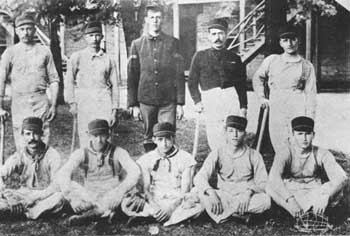





Survey of Historic Sites and Buildings
 |
JEFFERSON BARRACKS Missouri |
 |
| ||
Along the west bank of the Mississippi a few miles below St. Louis, this post was the successor of Fort Belle Fontaine (1805-26), established not long after the Louisiana Purchase north of the city on the Missouri River about 4 miles from its confluence with the Mississippi. Jefferson Barracks, founded in 1826 by troops from the fort under Capt. Stephen W. Kearny and Col. Henry Leavenworth, assumed its role as the western military headquarters. At the barracks in 1826 Colonel Leavenworth founded an infantry training school, and within a few years Col. Henry Dodge organized the 1st Dragoons.
Like the city on its northern flank, the barracks enjoyed a reputation as the "gateway to the West." It was the starting point of numerous military and exploring expeditions. Its excellent Mississippi River location facilitated the movement of personnel ordnance, and other supplies by steamboat along the Mississippi, Missouri, Ohio, Red, Arkansas, and Sabine Rivers—to frontier posts throughout the West and the Middle West and to such distant conflicts as the Black Hawk War (1832), chiefly in Wisconsin and Illinois; the second Seminole War (1835-42), in Florida; and the Mexican War (1846-48).
 |
| Troops assigned to noncombat posts had considerable time for recreation. Here is the Jefferson Barracks, Mo., baseball team in the 1880's. Two of the players later died in the Battle of Wounded Knee, S. Dak. (Arizona Pioneers' Historical Society) |
The barracks was originally an infantry training base, replacement center, and supply depot. During the Civil War, it served as a hospital and recuperation center. From 1894 through World War II, it functioned as an induction, training, supply, and replacement center. In 1850 an ordnance depot, a supplement to the St. Louis Arsenal, was added. In 1867, just to the south, a national cemetery was established. That same year the post became an engineer depot. In 1871 the Ordnance Department took over jurisdiction of the entire barracks for depot use, but 7 years later relinquished most of it for use in cavalry training. In 1894 the Army regarrisoned it as a regular military post.
Many of the noted military figures of the 19th century served at the post at one time or another, often as young lieutenants and sometimes as base commanders: Robert F. Lee, Ulysses S. Grant, Jefferson Davis, William T. Sherman, Philip H. Sheridan, Winfield Scott, James Longstreet, Joseph F. Johnston, Winfield S. Hancock, Henry Atkinson, John C. Fremont, Don Carlos Buell, George B. Crittenden, John B. Hood, and Zachary Taylor.
Since 1946, when the Army moved out, various Federal, State, and county agencies, as well as corporations and private individuals, have owned or leased parts of the reservation. Of primary interest is the county's Jefferson Barracks Historical Park, which covers 490 acres in the northern half of the reservation, formerly occupied by the ordnance depot. Restored limestone buildings consist of a two-story civilian laborer's house (1851), in its later years a guardhouse and barracks, now furnished to represent the 1850-65 period; a stable (1851), one story plus loft, once used as an icehouse; and a large one-story powder magazine (1857), surrounded by a stone wall, which presently houses a museum. The county plans to restore four other buildings.
 |
| Stables and laborer's house, both constructed in 1851, are today part of Jefferson Barracks Historical Park. (photo by Charles W. Snell, National Park Service) |
The Missouri National Guard utilizes 134 acres of the parade ground area. The original gray limestone structures that lined three sides of the parade ground in the years 1827-37 were torn down in the period 1891-95 and the parade ground enlarged to its present size. Dating from the latter period are six brick barracks and a guardhouse on the south side of the parade ground and an administration building on the east end. Adjoining the parade ground and extending to the south and southwest is a 309-acre national cemetery. A Veterans' Administration hospital occupies 136 acres in the southeast corner of the reservation.
 |
 |
http://www.cr.nps.gov/history/online_books/soldier-brave/sitec7.htm
Last Updated: 19-Aug-2005